Abstract
Agriculture plays a significant role in the labor force and GDP of Mozambique. Nonetheless, the energy source massively used for water pumping in irrigation purposes is based on fossil fuels (diesel oil). Despite the water availability and fertile soils in Moamba, Mozambique, farmers struggle with the high cost of fuels used in the pumping systems. This study was sought to analyze the feasibility of utilizing a solar photovoltaic system as a means to reduce the environmental impact caused by the diesel pumps and simultaneously alleviate the expenses regarding the use of non-environmentally friendly technologies. Site observations and interviews were undertaken in order to obtain local data regarding the water demand, current energy systems costs and distances from the source to the irrigated fields. CLIMWAT 2.0 was used for climate data acquisition and analysis. The environmental benefits, the cost effectiveness and local climate conditions show that the PV system is feasible in Moamba. Furthermore, parameters such as hydraulic energy, incident solar energy, pump efficiency and total system efficiency were used to predict the performance of the system. The results obtained are important to analyze the implementation of such energy systems.
1. Introduction
Agriculture is the basis for the development of many countries worldwide. For agriculture to provide food that is sufficient for the entire population, it is necessary to adopt mechanisms and technologies to help in this regard [1]. Past experiences have provided evidence that suggests that irrigation should be addressed in the context of a multidisciplinary approach that includes the Energy, Water Systems and Food nexus. In fact, energy, water resources and food are interconnected scarce resources that require approaches and technologies that will foster their sustainable management and effective utilization [2].
The agricultural sector may be a source for renewable energies, such as biofuel or biomass, but can also provide a pivotal contribution towards the mitigation of environmental impacts due to energy use by using sustainable energies [3]. In fact, research undertaken by [4] sought to find out the social and economic impact in shifting the fossil-based irrigation to renewable energy sources in India. Moreover, the study looked into the barriers imposed by politics in the booming of solar energy in the agriculture sector. Another study regarding the relation between energy and agriculture was carried out in [5], which aimed at understanding the economic feasibility of PV solar powered water pump systems, simulated with RETScreen international software. A similar study was conducted by [6] that studied the perks of the photovoltaic water pumping (PVWP) technologies focusing on the relation between the system operation and the customer profile in China.
To ensure the reliability of a photovoltaic system for water pumping, climatic conditions play a pivotal role in determining the extent to which the system will last longer and how efficient they will be [7]. In addition, pumped water control, analysis of system failures, repair delays and organizational aspects also have to be considered for the long-term reliability of the system, especially when it comes to systems that are employed in rural areas [8]. This is where the current study fits in terms of looking to local climatic conditions in order to determine the feasibility of the solar power system alongside the socio-economic conditions of the beneficiaries and their perspectives about the perks of the technology.
The concern with replacing the fossil fuel irrigation systems by sustainable energy systems is reinforced by [9], who undertook a pre-feasibility study to analyze the optimal condition to substitute the diesel-powered irrigation pumps by solar-PV-powered motor-pumps in Bangladesh. Moreover, [4] carried out a study in which diesel pumps were replaced by solar photovoltaics as a means to mitigate climate change impacts.
In Mozambique, research undertaken by [10] performed a qualitative analysis of horticultural crops water demand on a Solar Photovoltaic Water Pumping System (SPVWPS) design for irrigation in Boane, Mozambique. The study brought information on how crops can better perform based on the relation between water demand and horticultural crop development. Moreover, they concluded that Mozambique has favorable conditions to enhance the use of PVWPS for irrigation purposes and other electrical energy demands, taking into account the available solar radiation levels and general policy framework. Although the study focused on PVWPS, the site-specific conditions in different geographic points of the country are not taken into consideration. Thus, there is room for geographically specific studies. This is where this study fits.
Until 2016, the solar photovoltaic energy source was not in the energy mix of Mozambique [11]. Thanks to the government initiative called Energia para todos (Energy for All) in 2018, steps are being taken in order to raise the current energy access from rate from 30% to 70% by 2030. A similar initiative was undertaken in India [4]. The major difference between those two countries when it comes to renewable energy policies is that in India, the government prioritized the rural electrification based on renewable energy with grid connection, purchasing the minimum percentage of energy generated from such sources [12].
Despite the similarities of the initiatives, the Mozambican side lacks the integration of solar energy in the agricultural sector, which accounts massively for the GDP of the country, being responsible for 71% of its total GDP [13].
Since there is a number of factors and elements that have to be taken into account when deploying a PV solar system for irrigation, it is worth considering the local conditions (environment, water source, geographic location and social conditions of the beneficiaries). In spite of the daily load profile having little influence over the relative water deficit stressed by [14], the study does not consider the various water sources (rivers, boreholes, for example).
A study undertaken by [15], which aimed at comparing the performance of a diesel and solar photovoltaics power system in terms of costs and environmental impact, supports the idea of replacing diesel-based pumps with those driven by photovoltaics.
Since the dynamic head has influence in the cost of the irrigated field (the smaller the head, the lesser the cost) [16], the implementation of PV systems for water pumping in rural communities, where most of the people face poverty, is economically and socially recommended. However, it is important to consider the pump technology, a good selection of the PV technology and a more detailed design of water pumping systems [17].
The research results presented by [17,18] show how important it is to go through not only the scientific and technical knowledge of PV systems for water pumping irrigation, but also the local conditions (social, environmental and hydraulic) of system implementation.
One of the most well-known agriculture fields in Maputo is Moamba. In addition to its agricultural strength, the farmers face a lot of challenges when it comes to water pumping for irrigation purposes due to the overwhelming maintenance costs of diesel-based pumps.
The solar energy potential of the country places Mozambique at the top of the availability of energy resources in sub-Saharan Africa [18]. In this context, if solar energy brings advantages for agricultural activity [7,19], then site conditions may influence the real performance of the system and simultaneously the crop growth based on the rain fall profile, solar radiation, temperature, humidity, etc. Hence, this paper presents the current energy and irrigation scenario in Moamba on one hand, and the climate parameters on the other, which are peculiar to the study site. Furthermore, it discusses the economic impact of the energy source transition from fossil fuel based to solar photovoltaics for irrigation purposes.
2. Input Data
In order to analyze the feasibility of the water pumping PV system to be employed in Moamba, local data (head, irrigated crop, water source and water demand) were collected on site.
Therefore, parameters such as head (H), flow rate (Q), solar radiation (E) and PV power were analyzed in order to assess the technical feasibility of the system [20].
Environmental data regarding Moamba were collected from the CLIMWAT meteorological database, which receives information from on-site stations, including Moamba. The available data comprise mean values collected from 1971 to 2000 and compiled by the Food and Agriculture Organization (FAO).
In short, the input conditions considered for this study include the following local environmental conditions of Moamba: solar radiation, daily water requirements for irrigation, solar panel characteristics (Vmax, Imax), pump details, duration of crop irrigation per day, water flow rate, among others.
It was expected that through the input conditions, the study could provide information on how technically efficient the SPVWPS can be when deployed in Moamba. In addition, the local socioeconomic conditions of the population were also analyzed to have a clue on how the system can be bought among the beneficiaries. Lastly the study scrutinized how the political aspects related to the electricity services in Mozambique can be a hurdle or a perk in the massification of electricity access rate in agriculture, in particular.
2.1. Panel Characteristics
A PV array composed by 4 polycrystalline panels with 145 Wp each was considered for the analysis in order to predict the PV system performance, regarding Moamba’s local conditions. The data presented in Table 1 was taken from the panel data sheet.

Table 1.
Panel characteristics.
Data analysis was carried out by calculating parameters such as Pump Energy requirement (Ee), Hydraulic Energy (Eh), Incident Solar Energy (Ei), Pump Efficiency (ηP) and Total System Efficiency (ηsys), as suggested by [21]. These parameters helped to predict the performance of the PV system for water pumping, considering the conditions in Moamba.
Other parameters that were used in the expressions are: G—irradiance (W/m2/day); —water density (kg/m3); H—pumping head (m); Q—volumetric flow rate (l/s/ha); V—voltage (V); I—electric current (A); g—gravitational constant (9.81 m/s2); and Apv—Panel Area (m2).
The following expressions were used to obtain the parameter values.
- (a)
- Pump energy requirement (Ee);
Number of panels: 4;
Number of irrigation hours: 5;
- (b)
- Hydraulic Energy Generation (Eh)
- (c)
- Incident Solar Energy (Ei)
- (d)
- Pump efficiency (ηP)
- (e)
- PV system efficiency is
- (f)
- Total System efficiency (ηsys)
2.2. Geographical and Socio-Economical Characterization of Moamba
Moamba is a district of the Maputo Province in southern Mozambique. The district of Moamba is crossed by the Incomáti River, which gives its name to its important basin, and is born in South Africa, on the Transvaal plateau; it enters Mozambique through the Komatipoort gorge and leaves near the village of Moamba (Figure 1). Its tributaries in Mozambique are Massintonto and Sábiè located to the north of the district. The regime of these rivers is periodic with essentially pluvial feeding, originating a high flow in the rainy season from December to April, and, in Sábiè, from January to March, practically disappearing in the dry period. The Incomáti basin supplies the Sábiè-Incomáti irrigation system and the Corumana hydroelectric power station. The area of the district is 4628 square kilometres (1787 sq mi).
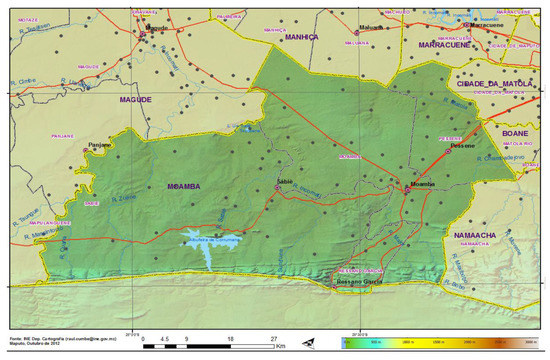
Figure 1.
Moamba district map, including its boundaries.
2.3. Population
The current population in Moamba is approximately 80,000 people. The population is expected to grow to up to 90,000 by 2030. There is a linear trend from year 2007 to 2020. The growth will remain steady and linear until 2030 [21].
2.4. Socioeconomics of the Population
The population from Moamba is mostly composed of farmers. The rate of uneducated people in 2007 was 35.5% for people in the age range of 30 to 39 years old, 41% for people in the range of 40 to 49 and 57.6% in the range of 50 to 59, according to the last database available [22].
To a large extent, income correlates with access to electricity, and income is influenced by geographic location. The income source is another useful indicator, as those with the same income source tend to have similar demographic characteristics (including income) and tend to live in similar types of locations [23].
Table 2 shows the percentage of adults with access to electricity by income source in Mozambique. As can be noted, farmers, such as the ones from Moamba, have the lowest income (10%) when compared to other income sources.

Table 2.
Percentage of adults with access to electricity by income source. Source: [23].
The houses are built with non-conventional material with just 2.5% of the dwellings possessing channeled water in 2007. Furthermore, 28.7% of the people obtain the water for their primary needs from boreholes, and another 29% use water from the river/lake [22].
2.5. Energy Mix in Mozambique
Mozambique’s average of global solar radiation is equal to 5.7 kWh/m2/day, and in Moamba, it is 5.3 kWh/m2/day [24]. The beam and diffuse components of solar radiation are 3.5 and 1.9 kWh/m2/day, respectively. These numbers provide a good insight on the feasibility of implementing solar PV water pumping for agricultural purposes in Moamba. In addition to this, the river is extremely close to the irrigated areas, which would make it more profitable and feasible for irrigation purposes.
The photovoltaic power potential in Mozambique can reach a maximum of 4.8 kWh/kWp in Tete and Manica provinces. In Maputo, where Moamba is located, the average energy potential is around 4.2 kWh/kWp. Figure 2 represents the energy potential in the country. The energy values in the Figure 2 refer to the 1994 to 2015 long-term average of daily/yearly sum.
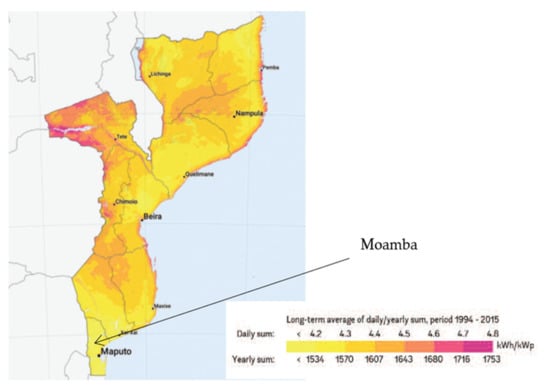
Figure 2.
Photovoltaic power potential in Mozambique [11].
Despite the abundance of solar energy in the country, that ultimately should be harnessed for electricity generation, Mozambican population is heavily reliant on traditional forms of energy: about 97% of the total household energy needs are still met by traditional biomass fuels such as wood and charcoal [25].
Mozambique has a very low electricity access rate compared to other countries in Sub-Saharan Africa. In 2017, only 27.4% of the population had access to electricity [14].
The electricity access rates in urban and rural areas in Mozambique are represented in Figure 3.
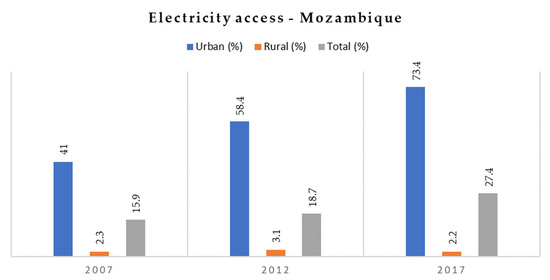
Figure 3.
Electricity access rates in rural and urban areas (2007, 2012, 2017). Source: [17].
2.6. Energy Mix in Moamba
The energy scenario in Moamba is mostly characterized by the use of fossil fuels (67%) used for lighting and agricultural purposes. Firewood is used for cooking purposes. The percentage of people who have access to electricity is roughly 18% according to the last survey in this regard [22]. The graph in Figure 4 depicts the main energy sources of energy used in Moamba.
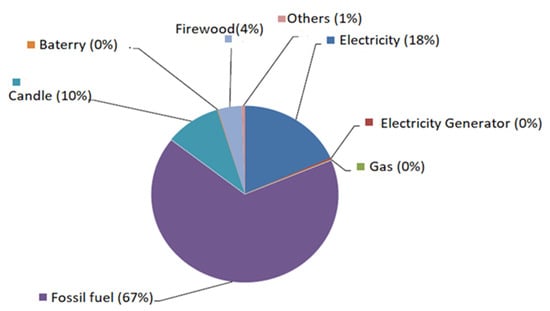
Figure 4.
Energy mix in Moamba. Reprinted with permission from [22]. Copyright 2021 Instituto Nacional de Estatísticas (INE).
2.7. Energy Tariff Applied to Agricultural Sector in Mozambique
In Mozambique, the electricity tariff varies from one energy consumer category to another. The agriculture category has the lowest energy tariff (roughly 0.042 USD/kWh). Despite this “bonus” offered by the government, the connection taxes to the electricity grid are unaffordable for most of the farmers, given their financial and social conditions. Table 3 presents the electricity tariff applied to a specific consumer category by the Electricity authority in Mozambique (EDM—Electricidade de Moçambique).

Table 3.
Energy tariff based on the consumer category. Source: [26].
2.8. Data Acquisition in the Research Field—Moamba
For data acquisition in Moamba, interviews and observation (including measurements) were adopted. The description of how these methods were carried out are described below.
2.8.1. Interviews
A sample of 10 farmers were interviewed by the authors. This a sample of farmers using diesel-based pumps for their irrigation out of 15 identified in the Moamba irrigation area. The sample was composed by 2 women and 8 men. The sample was indicated by the local government representation that oversees the commercial activities (SDAE—Serviços Distritais de Actividades Económicas—in Portuguese) in which the agricultural activity is included. It is important to point out that all interaction between the farmers in Moamba and any outsider must be done under its permission and indication. In order words, any research carried out in Moamba irrigation field has to be under license and permission from SDAE, as well as the people (farmers) to be interviewed. Essentially, all the farmers in Moamba are under supervision of the local government entity, which means that all the activities that one wants to undertake with the farmers must obtain approval from the government.
The aim of the interview was to find out what the real situation regarding the energy generation for water irrigation was and the costs related to the maintenance of the systems: monthly expenses, water demand, types of crops that are cultivated in the fields and their awareness about the utilization of solar photovoltaic systems in agriculture.
The rationale to undertake the interview was based on the fact that there must be an engagement of the beneficiaries (community/society) to the project to be implemented [27,28]. When a new technology or product is about to be introduced, the local community must be involved as a way of ensuring that the real beneficiaries will engage in it. The diagram presented in Figure 5 shows the relation that has to be established between the sociocultural context, the energy delivery model and the enabling environment.
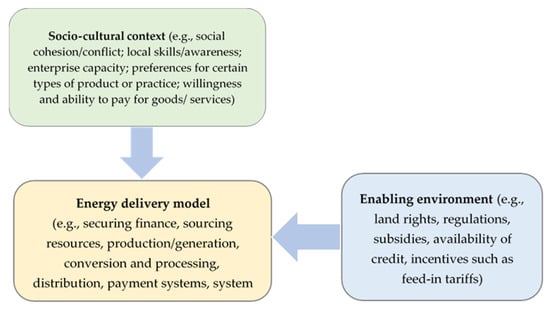
Figure 5.
Map of the pro-poor energy delivery system. Source: [29].
If one wants to implement a PV water pumping system in a community where it has never been deployed before, it is important to scrutinize their living model and technology acceptance. Furthermore, communication between the two parts (implementer and beneficiary) has to be as clear as possible. The knowledge of the local habits and uses with regard to water use, as well as future water needs, will allow a reliable system design [29].
2.8.2. Observations
In order to understand the status quo of the existing irrigation system and the technology applied for the irrigation, the site was observed during 5 different days.
2.9. Water Resource Evaluation
One of the steps to be undertaken prior to the implementation of any water supply related project consists in evaluating the water source in the implementation field. This is particularly important because one will be aware of what characteristics describe the water in that specific location [24].
Regarding the water resource in Moamba fields, the water source is a river, named the Incomáti river, which is also used for laundry, cattle drinking and, occasionally, the margin sand is extracted for civil construction purposes. This is affecting its natural profile in the extent that the sand blocks the river channel, affecting the irrigation activity in Moamba. Figure 6 shows how small the river became in one of its channels, from where a farmer takes the water.
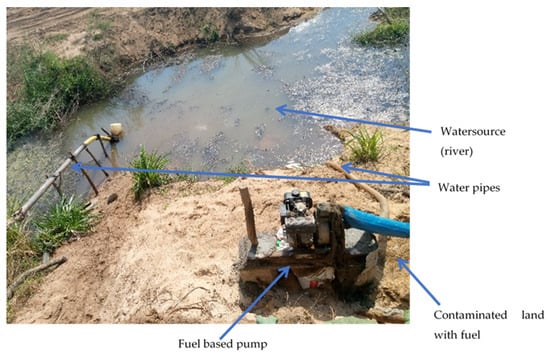
Figure 6.
Incomati river vs. Diesel pump.
2.10. Pump Characteristics for the PV System
For the current study, the pumping profile is described in Table 4. The elected crop for analysis is tomato, for which the water source is the Incomáti River. It was considered a 2 L/s/ha water demand.

Table 4.
Pumping characteristics and energy/irrigation needs in Moamba.
2.11. Climatic Conditions of Moamba
At this point, information regarding the simulation tool used to obtain the climatic data from Moamba is presented alongside the key environmental parameters that were analyzed in order to generate on-site environmental information.
Simulation Tools Used for Climatic Conditions Assessment
In order to evaluate the extent to which the local climate conditions can determine or influence the performance of the solar photovoltaic system on a specific site, climatic conditions have to be analyzed. So, parameters such as temperature, solar irradiation, humidity and wind speed are pertinent for a better assessment of a solar system.
When applying solar photovoltaics for irrigation purposes in agriculture, there is a relationship between the availability of solar irradiation and the water requirement of agricultural land that makes the utilization of solar power for water pumping consistent. When the weather is hot and solar irradiation is at its highest levels, the water requirement increases, and when the weather is cold and solar irradiation is less intense, the water requirement also decreases. Deploying solar-powered water pumping systems in rural areas alleviates the difficulties and high costs that are imposed to construct an electricity infrastructure [30].
In order to have a climate profile of Moamba, CLIMWAT 2.0 was used. CLIMWAT is a climatic database to be used in combination with the computer program CROPWAT and allows the calculation irrigation demands for a specific crop, based on climatic data gathered from various stations available all over the world [31].
CLIMWAT 2.0 for CROPWAT is a joint publication of the Water Development and Management Unit and the Climate Change and Bioenergy Unit of FAO. This electronic tool offers observed agroclimatic data of over 5000 stations worldwide, including Moamba.
CLIMWAT displays long-term monthly mean values of environmental parameters, such as:
- Mean daily maximum temperature in °C;
- Mean daily minimum temperature in °C;
- Mean relative humidity in %;
- Mean wind speed in km/day;
- Mean sunshine hours per day;
- Mean solar radiation in MJ/m2/day;
- Monthly rainfall in mm/month;
- Monthly effective rainfall in mm/month;
- Reference evapotranspiration.
Accurate data on crop water demands, the soil characteristics and environmental information is needed to improve irrigation water productivity and attain efficient water use. Rainfall and evapotranspiration play an important role when it comes to gauging the water balance in any irrigated crop [27]. The climatic conditions of Moamba, obtained from CLIMWAT 2.0, are presented in Table 5.

Table 5.
Moamba’s climatic conditions.
The temperature profile throughout the year (January to December) remains roughly constant in the first quarter of the year (with higher values), with a decrease from April to September. The rise in temperature comes in again in the last quarter of the year.
An important variant to better understand how the crop will behave according to local climatic characteristics is the evapotranspiration rate (ETo). Evapotranspiration is the combination of soil evaporation and crop transpiration. Weather parameters, crop characteristics, management and environmental aspects affect evapotranspiration. The evapotranspiration rate from a reference surface is called the reference evapotranspiration and is noted as Eto. It can be computed from weather data. Eto depicts the evapotranspiration power of the atmosphere at a given spot and time of the year and does not take into account the crop characteristics and soil variables [32].
Looking at the Eto reference values, they show that in months with high radiation, the evapotranspiration is higher, which will make the PV system perform better than in other months. Confronting these results with reference [33], their experimental results showed that the power output of a PV-green roof system can be higher than the reference PV installed on a bare concrete roof by about 8.60%, whereas the maximum improvement in efficiency can be up to 3%. It is found that Eto plays a significant role in reducing cell temperature and improving output on days with clear sky and fairly high and constant solar irradiance. In Moamba, most of the areas are covered by crops.
A glance to sun hours throughout the year in Moamba shows that the sun shines all over the day: sun duration is fairly constant from January to December.
Figure 7 shows the site climatic conditions all over the year. The graph reveals that the water pumping needs will have its peak in May, June, July, August, September and October. These are the months with low rainfall. Conversely, radiation, temperature and evapotranspiration keep fairly constant during the year. This will demand much water from the source (river), and, as a consequence, it will demand a good output in the PV system to provide enough pumping power.
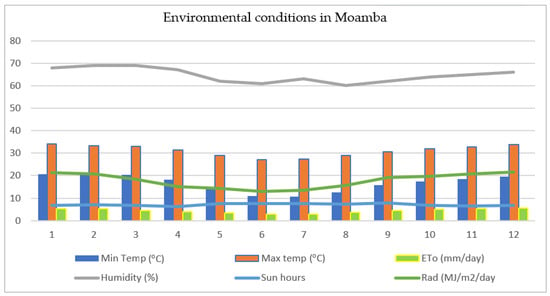
Figure 7.
Climatic parameters over the year in Moamba.
3. Results
The results of the study are presented according to the data collection and tools/equipment analysis.
3.1. Interviews
The interviews were used as a source of gauging the socioeconomic information of the farmers regarding the use of solar-powered pumps as a way of replacing the current fuel-based pumps in Moamba. In this regard, Table 6 presents the questions and systematized answers, since most of the answers were similar.

Table 6.
Questions and systematized answers from the farmers.
3.2. Technical Performance of the PVWPS
Based on Equations (1)–(6), the solar PV pumping system parameters were calculated. Table 6 presents the parameters and their corresponding values.
Since the paper sought to analyze the performance of an SPVWPS in a case study approach, local climatic conditions were also considered for the calculation of some pivotal parameters of an SPVWPS as a means to offset the current irrigation power source which is based on fuel.
Since it is important to determine the Hydraulic Energy Generation (Eh), the head of the source (river) was measured. The equation presented in (2) was used to obtain the Hydraulic Energy Generation, which is 653.3 Wh.
As for the Pump energy requirement (Ee), given by the expression given in (1), the Vmax and Imax of the solar panel and a string of four panels, connected in parallel, were taken into consideration. An irrigation duration of 5 h per day using a 16.2 kWh centrifugal pump was considered. Table 7 presents the SPVWPS parameters in Moamba.

Table 7.
SPVWPS parameters and values.
4. Discussion
A similar study undertaken by [34] sought to find out the feasibility of solar-powered irrigation system, focusing on its technical and economic aspects. It also takes into account the location aspects such as climate data, aquifer depth and political issues. Mathematical expressions were also used to determine the SPVWPS parameter values.
A study conducted by [35] scrutinized the feasibility of using an SPVWPS for different crops, analyzing the water saving in each of the crops. Moreover, it compared the economic expenses between diesel-based pumps and solar ones. Environmental aspects were also analyzed for both technologies.
Based on the site conditions and data collected from local site (water source characteristics, irrigation needs, the socioeconomic characteristics of Moamba and interviews, there are technical and environmental conditions for the deployment of a PV water pumping system. In line with this, the field study shows that for the long-term sustainability of any water pumping system, it is crucial that the solution is designed, deployed and maintained taking into account the social, environmental, economic and cultural context. In particular, it seems crucial to know what people really want and need and how they could be engaged in the final solution and provide simple maintenance actions during the system’s lifetime.
Some of the major factors that can be highlighted as a rationale for implementing the PV system in Moamba are as follows:
- Self-reliance: The farmers will no longer depend on fossil fuel as a source of electricity for water pumping purposes;
- Increase in agricultural production: Since the costs associated with diesel and electricity tariffs are a hurdle for the production increase, a PV system may definitely offer this opportunity;
- Diversification of electricity sources: Considering the number of farmers and different electricity sources used for water pumping, the deployment of a PV system would scaffold the use of renewable energy sources in the agricultural context;
- Sustainable energy awareness: The implementation of a PV water pumping system would raise the sustainable development and decrease climate change problems among the farmers.
However, it is noteworthy to look at some drawbacks that may come from it, which are as follows:
- Maintenance of the system: There is the risk of not performing the appropriate maintenance of the balance of the system, on one hand, and of the hydraulic components on another;
- Theft of the components: A significant number of PV systems in Mozambique face the problem of theft. Given the localization of Moamba, it is likely to have components stolen;
- Quick degradation of the panels: The dust that characterizes the land in Moamba and the humidity caused by the irrigation process can jeopardize the proposed system.
In summary, the Moamba irrigated area offers a range of conditions that justify the implementation of a PV system for irrigation purposes:
- (a)
- Localization: Moamba offers suitable geographical conditions that can enhance the electricity generation through solar PV systems. In addition, the rivers within the district provide hydraulic conditions for an unstoppable irrigation system;
- (b)
- Economic Conditions: The meager financial conditions that characterize most of the farmers in Moamba, high electricity connection taxes, lack of agriculture vs. energy incentive policies, unstable or inconsistent agricultural incomes and high and growing electricity tariffs are some elements that show how the PV system would be a good solution for the farmers;
- (c)
- Environmental Conditions: high solar radiation, good mean temperature, water and land pollution that arise from the use of diesel pumps;
- (d)
- Technical conditions: Unoccupied large areas, easy tilt identification, energy efficiency, high energy production and longevity of the BoS life cycle are some of the technical conditions that support the PV system’s implementation.
5. Conclusions
The paper began with a discussion on the feasibility of deploying a PV system for irrigation purposes in Moamba, since no similar study has been carried out in that specific site. The best evidence available in the literature suggests that the deployment of a PV system demands that the economic, environmental, and climatic conditions and the geographic location need to be well combined in order to have a good system performance. This study suggested that if a PV system for irrigation purposes is implemented in Moamba, farmers can have a better crop harvest while environmental, social and financial issues will be alleviated.
The interview responses showed that farmers should be involved in the implementation of the PV irrigation systems as a means to gauge the peculiarities regarding their agriculture practices. Based on the site climatic and technical characteristics, a very reliable solar photovoltaic system for irrigation purposes can be deployed.
Calculated parameters such as hydraulic energy, incident solar energy, pump efficiency and total system efficiency denote that a solar photovoltaic system (system efficiency of 3.7%) for water pumping can have a good technical performance in Moamba, confrontation with [19].
Author Contributions
Conceptualization, A.J.M., J.A.C., R.E.A. and A.C.O.; formal analysis: J.A.C. and R.E.A.; investigation, A.J.M., J.A.C., R.E.A. and A.C.O.; data curation, A.J.M., R.E.A. and A.C.O.; writing—original draft preparation, A.J.M. and J.A.C., writing—review and editing, R.E.A. and A.C.O. All authors have read and agreed to the published version of the manuscript.
Funding
The participation of Rui Esteves Araújo in this work was financed by National Funds through the Portuguese funding agency, FCT—Fundação para a Ciência e a Tecnologia, within project UIDB/50014/2020.
Institutional Review Board Statement
Not applicable.
Informed Consent Statement
Not applicable.
Data Availability Statement
Not applicable.
Conflicts of Interest
The authors declare no conflict of interest.
References
- Yahyaoui, I.; Atieh, A.; Serna, A.; Tadeo, F. Sensitivity analysis for photovoltaic water pumping systems: Energetic and economic studies. Energy Convers. Manag. 2017, 135, 402–415. [Google Scholar] [CrossRef] [Green Version]
- Barron-Gafford, G.A.; Pavao-Zuckerman, M.A.; Minor, R.L.; Sutter, L.F.; Barnett-Moreno, I.; Blackett, D.T.; Thompson, M.; Dimond, K.; Gerlak, A.K.; Nabhan, G.P. Agrivoltaics provide mutual benefits across the food–energy–water nexus in drylands. Nat. Sustain. 2019, 2, 848–855. [Google Scholar] [CrossRef]
- Martinho, V.J.P.D. Interrelationships between renewable energy and agricultural economics: An overview. Energy Strateg. Rev. 2018, 22, 396–409. [Google Scholar] [CrossRef]
- Kumar, P.; Rathore, S. Perspectives of solar photovoltaic water pumping for irrigation in India. Energy Strateg. Rev. 2018, 22, 385–395. [Google Scholar]
- Mehmood, A.; Waqas, A.; Mahmood, H.T. Economic Viability of Solar Photovoltaic Water Pump for Sustainable Agriculture Growth in Pakistan. Mater. Today Proc. 2015, 2, 5190–5195. [Google Scholar] [CrossRef]
- Zhang, C.; Campana, P.E.; Yang, J.; Yan, J. Economic performance of photovoltaic water pumping systems with business model innovation in China. Energy Convers. Manag. 2017, 133, 498–510. [Google Scholar] [CrossRef]
- Gao, Z.; Zhang, Y.; Gao, L.; Li, R. Progress on Solar Photovoltaic Pumping Irrigation Technology. Irrig. Drain. 2018, 67, 89–96. [Google Scholar] [CrossRef]
- Narvarte, L.; Lorenzo, E.; Aandam, M. Lessons from a PV pumping programme in South Morocco. Prog. Photovolt. Res. Appl. 2005, 13, 261–270. [Google Scholar] [CrossRef]
- Sarkar, N.I.; Sifat, A.I.; Rahim, N.; Reza, S.M.S. Replacing diesel irrigation pumps with solar photovoltaic pumps for sustainable irrigation in Bangladesh: A feasibility study with HOMER. In Proceedings of the 2015 2nd International Conference on Electrical Information and Communication Technologies (EICT), Khulna, Bangladesh, 10–12 December 2015; pp. 498–503. [Google Scholar]
- Chilundo, R.J.; Maúre, G.A.; Mahanjane, U.S. Dynamic mathematical model design of photovoltaic water pumping systems for horticultural crops irrigation: A guide to electrical energy potential assessment for increase access to electrical energy. J. Clean. Prod. 2019, 238. [Google Scholar] [CrossRef]
- Mantellassi, S.; Conforti, V.; Tenti, D. Solar Investment Opportunities Emerging Markets Task Force Report; Technical Report for SolarPowerEurope: Onehemisphere, Sweden, 2019. [Google Scholar]
- Kumar, S. Renewable and sustainable energy reviews solar photovoltaic energy progress in India: A review. Renew. Sustain. Energy Rev. 2016, 59, 927–939. [Google Scholar]
- World Bank. Policy Matters—Regulatory Indicators for Sustainable Energy. In Alternatives to Exclusion from School; World Bank: Washington, DC, USA, 2018; pp. 31–48. [Google Scholar]
- Arab, A.H.; Chenlo, F.; Mukadam, K.; Balenzategui, J.L. Performance of PV water pumping systems. Renew. Energy 1999, 18, 191–204. [Google Scholar] [CrossRef]
- Rehman, S.; Sahin, A.Z. Performance comparison of diesel and solar photovoltaic power systems for water pumping in Saudi Arabia. Int. J. Green Energy 2015, 12, 702–713. [Google Scholar] [CrossRef]
- Hamidat, A. Simulation of the performance and cost calculations of the surface pump. Renew. Energy 1999, 18, 383–392. [Google Scholar] [CrossRef]
- Chandel, S.S.; Nagaraju Naik, M.; Chandel, R. Review of solar photovoltaic water pumping system technology for irrigation and community drinking water supplies. Renew. Sustain. Energy Rev. 2015, 49, 1084–1099. [Google Scholar] [CrossRef]
- Power Africa. Energy Sector Overview—Mozambique. 2018. Available online: www.usaid.gov/powerafrica (accessed on 23 May 2021).
- Chilundo, R.J.; Mahanjane, U.S.; Neves, D. Design and Performance of Photovoltaic Water Pumping Systems: Comprehensive Review towards a Renewable Strategy for Mozambique. J. Power Energy Eng. 2018, 6, 32–63. [Google Scholar] [CrossRef] [Green Version]
- Benghanem, M.; Daffallah, K.O.; Alamri, S.N.; Joraid, A.A. Effect of pumping head on solar water pumping system. Energy Convers. Manag. 2014, 77, 334–339. [Google Scholar] [CrossRef]
- Tiwari, A.K.; Kalamkar, V.R. Effects of total head and solar radiation on the performance of solar water pumping system. Renew. Energy 2017, 118, 919–927. [Google Scholar] [CrossRef]
- Instituto Nacional de Estatísticas (INE). Estatísticas do Maputo Citade. 2013. Available online: http://www.ine.gov.mz/ (accessed on 23 May 2021).
- Naidoo, K.; Loots, K. Mozambique—Energy and the Poor—Unpacking the Investment Case for Clean Energy; UNDP: New York, NY, USA, 2020. [Google Scholar]
- FUNAE. Atlas de Energias Renovaveis—Moçambique; FUNAE Fundo de Energia: Maputo, Mozambique, 2013. [Google Scholar]
- Mahumane, G.; Mulder, P. Mozambique Energy Outlook, 2015–2030. Data, Scenarios and Policy Implications. 2015. Available online: https://ssrn.com/abstract=2644144 (accessed on 11 April 2021).
- EDM. Electricidade de Moçambique. 2017. Available online: https://www.edm.co.mz/pt/website/page/tarifário-de-energia-eléctrica (accessed on 20 May 2021).
- Di Felice, L.J.; Ripa, M.; Giampietro, M. An alternative to market-oriented energy models: Nexus patterns across hierarchical levels. Energy Policy 2019, 126, 431–443. [Google Scholar] [CrossRef]
- Wilson, E.; Wood, R.G.; Garside, B. Sustainable energy for All? Linking Poor Communities to Modern Energy Services; IIED: London, UK, 2012; ISBN 9781843698654. [Google Scholar]
- Fedrizzi, M.C.; Ribeiro, F.S.; Zilles, R. Lessons from field experiences with photovoltaic pumping systems in traditional communities. Energy Sustain. Dev. 2009, 13, 64–70. [Google Scholar] [CrossRef]
- Deveci, O.; Onkol, M.; Unver, H.O.; Ozturk, Z. Design and development of a low-cost solar powered drip irrigation system using Systems Modeling Language. J. Clean. Prod. 2015, 102, 529–544. [Google Scholar] [CrossRef]
- FAO. 2021. Available online: http://www.fao.org/land-water/databases-and-software/climwat-for-cropwat/en/ (accessed on 11 April 2021).
- Raes, D.; Munoz, G. The ETo Calculator, Version 3.2; Reference Manual; FAO: Roma, Italy, 2009; pp. 1–3. [Google Scholar]
- Gupta, S.; Anand, P.; Kakkar, S.; Sagar, P.; Dubey, A. Effect of evapotranspiration on performance improvement of photovoltaic-green roof integrated system. Int. J. Renew. Energy 2017, 12, 63–76. [Google Scholar]
- Kelley, L.O.; Gilbertson, E.; Sheikh, A.; Eppinger, S.D.; Dubowsky, S. On the feasibility of solar-powered irrigation. Renew. Sustain. Energy Rev. 2010, 14, 2669–2682. [Google Scholar] [CrossRef]
- Hossain, M.A. Technical and economic feasibility of solar pump irrigations for eco-friendly environment. Proced. Eng. 2015, 105, 670–678. [Google Scholar] [CrossRef] [Green Version]
Publisher’s Note: MDPI stays neutral with regard to jurisdictional claims in published maps and institutional affiliations. |
© 2021 by the authors. Licensee MDPI, Basel, Switzerland. This article is an open access article distributed under the terms and conditions of the Creative Commons Attribution (CC BY) license (https://creativecommons.org/licenses/by/4.0/).